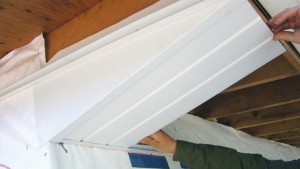
How to install vinyl siding
Vinyl siding, a popular exterior wall finish, expands and contracts significantly with changing temperatures. To allow for this movement, it must be installed correctly. The only specialized tools you will need to install vinyl siding are (1) a nail hole punch, for punching holes in cut panels; (2) a snap-lock punch, for dimpling panels where they are pressed into utility trim; and (3) an unlocking tool. Vinyl siding can be cut with tin-snips, with a circular saw fitted with a plywood blade, or by scoring the panel with a knife and snapping it in two.

Once the building wrap and vertical J channel have been installed, the starter strip is nailed over the wrap and fit into the J channel. The first piece of siding panel snaps over the starter strip and extends into the J channel.
The basic components to install vinyl siding are:
- Siding panels, usually in 12-foot-6-inch lengths, with a nailing flange along the top edge. Just below the nailing flange is a lip or “locking” channel, and along the bottom edge is a “J” shape that interlocks to the locking channel on the panel below.
- J-channel is used to trim the cut end of the siding panels – typically, where the siding meets windows and doors.
- Inside corners cover the cut ends of panels where they meet at an inside corner of the wall.
- Outside corners cover the cut ends of panels where they meet at an outside corner of the wall.
- Under-sill or utility trim has a tight loop rather than an open “J”. These are used anywhere the nailing flange has been cut off the siding panel, usually below windows or eaves. The cut edge of the siding panel can be dimpled with the snap-lock punch to allow it to snap into the utility trim.
- The Starter Strip determines the height and level of your initial siding panel. The strip has a nailing flange and locking channel that will interlock with the “J” channel along the bottom of the siding panel.
- Fascia panels cover the vertical face of the fascia.
- Soffit panels usually come in 12-foot rolls and must be cut to width. They cover the underside of flat or pitched soffited eaves.
Before you install vinyl siding
An aluminum fascia wrap is installed to cover the wood fascia board, and a bend at the bottom of the pane covers the rough end of the soffit. Before you install vinyl siding, tie any loose branches or shrubs away from the house so you have ample room to work. Then remove anything that will interfere with the installation, such as gutters and downspouts, light fixtures and shutters. Scrape out any caulk between old siding and windows and doors so the new vinyl trim pieces will fit better.
If the walls are uneven, shim out low spots with wood furring. If you are covering old lap siding, nail the furring over the siding at 16 inches off center from the foundation to the eaves. Also nail furring around all windows and doors.
Keep it level
Using a dry line or laser, determine which corner of the house is lowest. Measure up from that corner the distance specified by the siding manufacturer. At that point; snap a level chalk line around the perimeter of the house. Using that line as your guide, nail on the starter strip, and leave ¼-inch between pieces that butt together.

Soffit panels are installed into a J channel along the face of the wall and nailed to the underside of the existing wood fascia. For this application, aluminum soffit was used because it is easier to shape it to match the fascia.
Install all inside and outside corner trim pieces. Use a small piece to locate the edges, and snap a vertical chalk line to keep the pieces straight. The corner pieces should begin ¼ inch from the eaves and extend ¼ inch below the bottom of the siding.
Install J-channel at the top of the wall where the siding will end; on the sides and across the tops of all doors and windows, where the soffit meets the wall face; and behind the fascia board of all soffits and eaves. Where soffits/eaves turn a corner, you can install back-to-back J-channels at a 45-degree angle from the outside corner of the eave to the corner of the wall and fit angle-cut soffit panels to make the transition.
Cut the soffit panel to the correct span and install it between the J-channels. Remember to cut the panels ¼ inch short of the span.
Remove any gutters and nail the fascia cover panels at about 4-foot off center. Then replace the gutters.

A bent piece of aluminum has been installed over the wrap to act as sill flashing. Over that, a typical outside corner piece has been installed to receive the siding panels.
Beginning at the starter strip, install siding panels with 1-inch overlap where the panels meet. Use galvanized nails, and keep all nails 1/16 inch “proud” of the vinyl surface to allow for movement. Never nail through the vinyl. Always use the slot provided, or create a slot with the nail hole punch on cut pieces. Position nails in the center of the slot so side-to-side movement can occur.
Start the first panel of each course at the end opposite the most common view so subsequent overlaps face away and are less noticeable.
Once you interlock a siding panel to the one below, let it hang before nailing. Do not pull the panel up tight.

A siding panel has been measured and cut, and the notch has been removed so it can be installed under the window.
Stagger joints about 4 feet apart, and remember to leave ¼ inch wherever a panel butts into a corner or J channel.
Keep things straight – snap level lines at 4- or 8-inch increments horizontally. Align panels with the tops of windows and doors when possible, and adjust the starter strip accordingly. When a panel must be notched to fit below a window, mark the cut out section and then cut vertically with snips.
Score the panel horizontally and snap it apart. Use the snap-lock punch to dimple the cut edge at 16 inch off center with the lugs on the outside of the panel, then insert into the under-sill trim. Where panels overlap, cut away the nailing hem so there is ¼ inch between them. This will prevent the panels from buckling when they expand.

